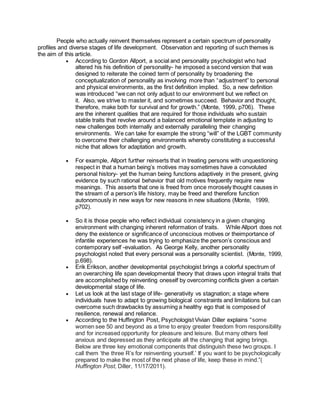
Personality Reinvention
- 1. People who actually reinvent themselves represent a certain spectrum of personality profiles and diverse stages of life development. Observation and reporting of such themes is the aim of this article. According to Gordon Allport, a social and personality psychologist who had altered his his definition of personality- he imposed a second version that was designed to reiterate the coined term of personality by broadening the conceptualization of personality as involving more than “adjustment” to personal and physical environments, as the first definition implied. So, a new definition was introduced “we can not only adjust to our environment but we reflect on it. Also, we strive to master it, and sometimes succeed. Behavior and thought, therefore, make both for survival and for growth.” (Monte, 1999, p706). These are the inherent qualities that are required for those individuals who sustain stable traits that revolve around a balanced emotional template in adjusting to new challenges both internally and externally paralleling their changing environments. We can take for example the strong “will” of the LGBT community to overcome their challenging environments whereby constituting a successful niche that allows for adaptation and growth. For example, Allport further reinserts that in treating persons with unquestioning respect in that a human being’s motives may sometimes have a convoluted personal history- yet the human being functions adaptively in the present, giving evidence by such rational behavior that old motives frequently require new meanings. This asserts that one is freed from once morosely thought causes in the stream of a person’s life history, may be freed and therefore function autonomously in new ways for new reasons in new situations (Monte, 1999, p702). So it is those people who reflect individual consistency in a given changing environment with changing inherent reformation of traits. While Allport does not deny the existence or significance of unconscious motives or theimportance of infantile experiences he was trying to emphasize the person’s conscious and contemporary self -evaluation. As George Kelly, another personality psychologist noted that every personal was a personality scientist. (Monte, 1999, p.698). Erik Erikson, another developmental psychologist brings a colorful spectrum of an overarching life span developmental theory that draws upon integral traits that are accomplished by reinventing oneself by overcoming conflicts given a certain developmental stage of life. Let us look at the last stage of life- generativity vs stagnation; a stage where individuals have to adapt to growing biological constraints and limitations but can overcome such drawbacks by assuming a healthy ego that is composed of resilience, renewal and reliance. According to the Huffington Post, Psychologist Vivian Diller explains “some women see 50 and beyond as a time to enjoy greater freedom from responsibility and for increased opportunity for pleasure and leisure. But many others feel anxious and depressed as they anticipate all the changing that aging brings. Below are three key emotional components that distinguish these two groups. I call them ‘the three R’s for reinventing yourself.’ If you want to be psychologically prepared to make the most of the next phase of life, keep these in mind.”( Huffington Post, Diller, 11/17/2011).
- 2. Furthermore, we can learn from research such a CBS morning show in which a relationship expert identified a way to encourage newly divorced woman to think of “60 as the new 20.”- tapping into the girls they once were and reinvent themselves. (Huffington Post, Diller, 11/17/2011). References: Diller, Vivian. (November, 17, 2011). Reinventing Yourself at Midlife. Huffington Post. Online at www.huffingtonpost.com/.../reinventing-yourself-at-m_b_63390 Monte, Christopher F. Beneath the Mask: An Introduction to Theories of Personality. United States Of America: Harcourt Brace College Publishers. 1999.